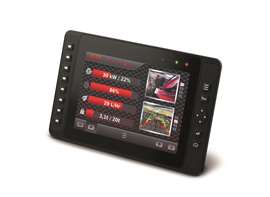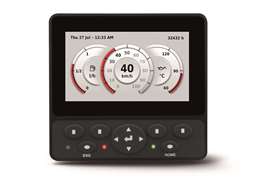Key trends in HMI and telematics for off-highway equipment
13 August 2024
Power Progress International recently interviewed experts at Danfoss Power Solutions about the latest telematics and HMI technology for off-highway use. Here are the top 3 key takeaways.
Operating off-highway equipment is no longer about simply speed, direction and the operation of implements. Electronics now monitor and gather a wealth of data, and human-machine interface (HMI) panels have the ability to provide that data — or an analysis of it — to operators for improved performance.
Power Progress International recently spoke to telematics and HMI experts at Danfoss Power Solutions about the latest technology for off-highway use. Here are three key takeaways from that interview.
HMI Form Factors
Lower costs and the need to show more machine information is driving a trend in larger in-cab screen sizes, according to Herman Oberoi, senior portfolio manager for displays at Danfoss Power Solutions.
 The Danfoss DM1000B display. (Photo: Danfoss)
The Danfoss DM1000B display. (Photo: Danfoss)
“Alongside larger screens, there’s a need for larger graphics which offer a clear view of relevant details,” he said. “Gauges are a good example where readability is important.”
Oberoi added that larger screens have the advantage of providing the operator with more information on a single screen.
“Space management requirements in new cabin designs are another influence,” he said. “This creates the need to show consolidated, yet more detailed, information on bigger screens in one glance.”
Projecting data onto a machine’s windscreen is another possibility, but OEMs must ask themselves if such an approach adds value to the operator.
“It may be more convenient and safer, in the case of critical alerts, to see information displayed within the operator’s line of sight,” Oberoi said, adding that the need for an operator to look away frequently at a display may be a bigger safety issue than looking at translucent graphics on the windscreen.
Nonetheless, Oberoi said that some applications still require the use of physical buttons in lieu of a touchscreen display. This is particularly true for equipment OEMs in China and Europe.
“We are also seeing some inclinations to stick with physical buttons, as well as CAN (Controller Area Network) keypads on the armrest, in some regions and for certain applications where safety concerns are higher,” he said.
More Telematics Integration
Advancements in telematics and the insights it can provide are driving the availability of such data in HMI systems.
“Greater use of telematics data in HMIs is something we see happening already, with other areas coming soon,” said Mohamed Abd El Salam, senior portfolio manager, IoT & Connectivity at Danfoss Power Solutions. “It all depends on what the machine manufacturer wants to program into the display.”
El Salam shared some use case examples, which included notifications about software updates and real-time views of machine conditions intended to foster predictive maintenance.
He added that telematics is enabling bidirectional communication between equipment and web portals. This reduces the machine’s processing load by allowing data processing to occur elsewhere.
“OEM recommendations generated from that data — the machine requiring inspection or service, for example — is then sent back to the machine HMI for the operator to act upon. This can be a technique for OEMs or dealers to sell services and maintenance programs.”
AI Ascending
One way HMI systems might be made less complicated is via artificial intelligence (AI). A time may come when AI can be responsible for certain machine activities, freeing up operator interaction with HMI.
“AI, especially generative AI, is creating a lot of opportunities and breakthroughs in many industries,” El Salam said. “The off-highway industry is still exploring how to best utilize the tech to increase productivity and efficiency of machines and operators.”
When it comes to autonomous operation, however, El Salam emphasized the continued importance of human oversight.
“Autonomous functionality could certainly embrace AI, especially where a machine can take over for the operator to perform a task more precisely or safely,” he said. “As for whether AI can be relied upon to make critical operation decisions, this is a possibility, but it might be pushed to the operator as a recommendation via HMI – maybe never executed in a fully autonomous way.”
Oberoi added that fully autonomous machine operations — one that remove the need for operator interaction — is still only a distant possibility.
“There are safety considerations that require an operator either in the cabin of the machine or nearby, and both of these cases would need an HMI cluster to monitor and oversee the machine, even if fully autonomous,” he said.
Editor’s Note: This article was written with the assistance of AI tools, with human oversight.






